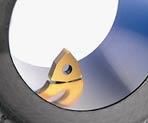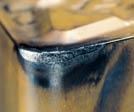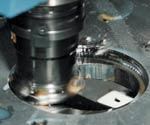Inserts For Difficult Materials
Economic efficiency is an important consideration when choosing tools for challenging metals.
Share






.png;maxWidth=45)
DMG MORI - Cincinnati
Featured Content
View More
Takumi USA
Featured Content
View MoreFully hardened steels, hard powder-metals, heat resistant superalloys, and bimetals are all gaining broader acceptance in industry. While such materials deliver practically indestructible parts, they come with this difficulty: how to machine them to final shape at a reasonable cost per part. Fortunately, cutting tool suppliers have made dramatic advances in inserts for milling and turning the difficult materials. Today’s coated carbide, cermet, cubic boron nitride (CBN), and polycrystalline diamond (PCD) inserts all play a role. Advanced material inserts with special geometries and coatings withstand mechanical shock and heat while resisting abrasive wear. However, using these inserts productively can require various external factors—one of which may be a partnership with a knowledgeable tool supplier.
Because the cost of cutting inserts is relatively low—typically just 3 percent of total machining costs with carbide inserts and 5 to 6 percent with CBN—using cheaper inserts may be a false economy. Advanced material inserts can pay for themselves in shortened cycles times or more good parts per shift.
On the other hand, filling a large milling cutter with exotic inserts unnecessarily is a costly mistake. CBN inserts can cost eight to ten times as much as carbide. And running these advanced material inserts at the wrong speed and feed rate compromises part quality and tool life. With difficult stock, picking the right inserts requires an appreciation for both machining economics and the overall process.
Payoffs And Tradeoffs
Consider the entire application. Less expensive carbide inserts that can do the job in terms of tolerance and surface finish may be costly when the time spent indexing and replacing inserts is considered. Real productivity results from an understanding of the tradeoffs in throughput, cycle time and insert performance.
In one specialized, low-volume example, a sintered titanium carbide gas turbine blade was milled successfully with coated carbide cutting inserts. At 120 sfm, the carbide cutting edge cut well for just 5 to 10 minutes. Acceptable insert life is typically placed at 15 to 30 minutes in high volume production with difficult materials, but with a low-rate part, the short insert life and frequent tool changes are not major drawbacks. Longer insert life does become important in full production, however, to decrease tool-changing downtime and labor and to increase machine utilization and throughput. Carbide works well for the turbine blade for now, but should the part go to higher volume production, the application may justify harder, more costly inserts made of CBN.
Productivity with advanced material inserts requires adopting the right feeds and speeds. Sandvik Coromant’s CBN inserts incorporate reinforced, chamfered edges to eliminate the edge breakout common when cutting materials harder than 50 RC. Yet even despite this toughness, CBN inserts demand cutting machine parameters held to tight tolerances. Cutting speeds 10 percent too low or 10 percent too high can dramatically hamper performance.
If faced with the need to machine a difficult material, consider contacting your cutting tool supplier. Suppliers can offer solutions based on how others have approached the same problem. When experimentation is required, careful trial-and-error generally starts with carbide inserts and moves on to harder and more costly cutters. Modern insert geometries, rigid toolholders and refined machining routines often make less costly carbide inserts suitable for tough jobs. When to move beyond carbide will vary from application to application, but broad classes of materials do pose common machining challenges.
Hardened Steels
Steel alloys for many applications are becoming harder. While tool steels were once considered hard at 45 RC, steels hardened to 63 RC are now common in the die and mold industry. Mold makers who once cut parts only before heat treating are now precision machining tool steels in the fully hardened condition to avoid heat treating distortion. The heat and pressure encountered when milling the fully hardened alloys can cause plastic deformation in cutting inserts and rapid insert failure.
Even so, fully hardened steels can be machined economically with carbide. One example involves aerospace machining. A major aerospace manufacturer switched to Sandvik GC1025 carbide inserts to re-bore a massive forging of hardened Type 300M steel, 4340 modified. Most of the metal is removed before heat treating when the steel has a hardness of 30 to 32 RC. However, to correct for distortion, precision holes in the big workpiece must be re-bored once the stock is fully hardened to 54 or 55 RC.
One particularly challenging feature deep within the part requires three re-boring passes to achieve the required tolerance and finish. The hard material combined with interrupted cutting wore out cermet cutting edges after less than one pass. This was particularly alarming given that a broken edge could ruin a part. In contrast, advanced fine-grain carbide inserts with their tough physical vapor deposition (PVD) coating and sharp cutting action lasted from six to nine cuts. To exploit the carbide inserts, the tool supplier recommended reducing the cutting speed from 300 sfm to 175 sfm but retaining the same depth of cut. Three passes through the bore at this lower speed took about 20 minutes with carbide inserts versus more than an hour with cermet cutters. More important, the added edge security of the carbide inserts minimized the risk of a broken edge scrapping an expensive workpiece.
To establish machining parameters to mill hardened steels with carbide inserts, generally start at 100 sfm. Test cuts can build up to speeds from 150 to 180 sfm. Usual feed rate is 0.003 to 0.004 inch per tooth. Insert geometries with a neutral or slight negative rake typically provide stronger edges than positive-rake inserts. Round carbide inserts also afford advantages when machining hard steels. The profile provides a stronger tool without vulnerable sharp corners.
When choosing among carbide grades, consider toughened grades. They provide edge security against the high radial cutting forces and severe entry and exit shock encountered in hardened steels. Alternatively, specially formulated high-temperature grades can withstand the heat generated by steels hardened to 60 RC. Shock resistant carbide inserts with an aluminum oxide coating can also counter the high temperatures generated by milling hard steels.
Sintered Metals
Advances in powder metallurgy are producing extra-hard sintered metals for a range of applications. One manufacturer developed a powdered nickel composite alloy containing tungsten or titanium carbide to achieve hardnesses from 53 to 60 RC. The carbide particles within the nickel-alloy matrix can reach 90 RC. When milling such materials, coated carbide inserts suffer rapid flank wear, and their primary cutting edges wear flat. Extra-hard particles within the microstructure create “microchatter” that accelerates insert wear. Carbide inserts can also fracture under the shear pressure of machining the hard stock.
CBN inserts provide a productive means to cut hard powder metals containing tungsten and titanium carbides. Advanced geometries can overcome microchatter. One user milling the powdered composite alloy found that an advanced CBN insert lasted better than 2,000 times longer than the best carbide inserts. A five-insert face mill running at 200 sfm and 0.007 inch feed per edge completed test cuts in the hard stock 75 percent faster than electrical discharge machining.
To make best use of CBN, cutting parameters must be maintained within a tight band. Speeds around 160 sfm and feeds of just 0.004 to 0.006 inch per tooth appear slow, but they are highly productive when machining sintered materials. Exact machining parameters are best determined by 30- to 60-second test cuts. Start at low speeds and build up until cutting edges show excessive wear.
Difficult materials should generally be machined dry to maintain consistent temperature on cutting edges. In most cases, a rounded cutter with double-negative geometry is most effective, and depth of cut is typically limited to 0.04 to 0.08 inch.
Milling cuts are by definition interrupted cuts. The constant hammering in materials hardened to Rockwell 60 or higher causes unique machining stresses. Machines and tooling must therefore provide maximum rigidity, minimum overhang and maximum strength to accommodate the high shock loads during machining.
Superalloys
Heat resistant superalloys (HRSAs) developed for the aerospace industry are gaining broader acceptance in automotive, medical, semiconductor and power-generation applications. Familiar HRSAs such as Inconel 718 and 625, Waspalloy, and titanium 6Al4V are now joined by newer titanium matrix and aluminum-magnesium matrix materials. All pose machining challenges.
Superalloys are hard; some grades of titanium are machined at 330 Brinell hardness. With conventional alloys, cutting zone temperatures greater than 2,000°F soften molecular bonds and create a flow zone for chips. In contrast, the heat resistance that makes HRSAs so desirable keeps them hard throughout the machining cycle.
HRSAs also tend to work-harden as they are cut, notching cutting inserts to premature failure. The difficulty cutting HRSAs is compounded where unpeeled stock is covered with abrasive, knife-edged scale that wears cutting edges down even more quickly.
Given their machining difficulty, superalloys are cut slowly. For example, Inconel 718 is milled for brake keys with Sandvik GC2040 grade carbide inserts at 200 sfm. Turning speed for the same alloy with Sandvik 7020 CBN inserts in an outside turning/facing application is 260 sfm. By comparison, uncoated carbide inserts typically cut tool steels at 400 to 800 sfm. Feeds for HRSAs are generally comparable to those used when machining tool steels.
The choice of cutting inserts to machine HRSAs depends on the material and the workpiece. Carbide inserts with positive rake geometries will cut thin-walled HRSA stock effectively. However, thick-walled parts may require ceramic inserts with negative cutting edge geometry to create a more productive plowing action. While dry machining is preferred in most difficult materials to maintain uniform edge temperatures, titanium requires coolant even at very low speeds.
The sustained hardness of HRSAs accelerates wear on the nose radii of cutting inserts. A round insert with no sharp corner provides the strongest cutting edge, but the work-hardening common to HRSAs leads to progressive insert notching. Varying the depth of cut for consecutive machining passes avoids work-hardened zones, eliminates notch buildup, and prolongs the life of cutting edges. The depth of cut could vary from 0.300 inch on one pass to perhaps 0.125 inch and 0.100 inch on subsequent cuts.
Bimetals
Bimetal components put hard materials in select wear areas surrounded by or mixed with softer alloys. They are gaining popularity in the automotive industry and elsewhere, and they pose special machining challenges. The CBN inserts that are so productive cutting alloys with greater than 50 Rc hardness can fracture if they hit softer materials. PCD inserts able to machine abrasive aluminum suffer excessive wear cutting ferrous metals.
Machining bimetals productively calls for refined machining routines developed by the user, tool supplier and machine vendor. In one application, the hard powder metal composite alloy described earlier was hot isostatically pressed onto a less costly 316 stainless steel substrate. A helically interpolated tool path programmed into the machine control applied optimum feeds and speeds to machine the powder metal zone first, then the backing.
To machine bimetal cylinder blocks productively, automakers must contend with both abrasive aluminum alloys and cast iron cylinder liners. The design of the part means hard iron wear zones cannot be isolated from the soft aluminum. However, machine programs providing very low speeds and very light depths of cut enable abrasion-resistant PCD inserts to machine both aluminum and iron without frequent tool changes.
Related Content
Toolpath Improves Chip Management for Swiss-Type Lathes
This simple change to a Swiss-type turning machine’s toolpath can dramatically improve its ability to manage chips.
Read MoreFinding the Right Tools for a Turning Shop
Xcelicut is a startup shop that has grown thanks to the right machines, cutting tools, grants and other resources.
Read MoreHow to Accelerate Robotic Deburring & Automated Material Removal
Pairing automation with air-driven motors that push cutting tool speeds up to 65,000 RPM with no duty cycle can dramatically improve throughput and improve finishing.
Read MoreHigh-Feed Machining Dominates Cutting Tool Event
At its New Product Rollout, Ingersoll showcased a number of options for high-feed machining, demonstrating the strategy’s growing footprint in the industry.
Read MoreRead Next
Registration Now Open for the Precision Machining Technology Show (PMTS) 2025
The precision machining industry’s premier event returns to Cleveland, OH, April 1-3.
Read More5 Rules of Thumb for Buying CNC Machine Tools
Use these tips to carefully plan your machine tool purchases and to avoid regretting your decision later.
Read MoreBuilding Out a Foundation for Student Machinists
Autodesk and Haas have teamed up to produce an introductory course for students that covers the basics of CAD, CAM and CNC while providing them with a portfolio part.
Read More


































.png;maxWidth=300;quality=90)




















